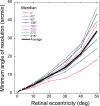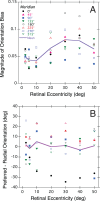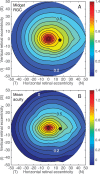Neural bandwidth of veridical perception across the visual field
- PMID: 26824638
- PMCID: PMC5833322
- DOI: 10.1167/16.2.1
Neural bandwidth of veridical perception across the visual field
Abstract
Neural undersampling of the retinal image limits the range of spatial frequencies that can be represented veridically by the array of retinal ganglion cells conveying visual information from eye to brain. Our goal was to demarcate the neural bandwidth and local anisotropy of veridical perception, unencumbered by optical imperfections of the eye, and to test competing hypotheses that might account for the results. Using monochromatic interference fringes to stimulate the retina with high-contrast sinusoidal gratings, we measured sampling-limited visual resolution along eight meridians from 0° to 50° of eccentricity. The resulting isoacuity contour maps revealed all of the expected features of the human array of retinal ganglion cells. Contours in the radial fringe maps are elongated horizontally, revealing the functional equivalent of the anatomical visual streak, and are extended into nasal retina and superior retina, indicating higher resolution along those meridians. Contours are larger in diameter for radial gratings compared to tangential or oblique gratings, indicating local anisotropy with highest bandwidth for radially oriented gratings. Comparison of these results to anatomical predictions indicates acuity is proportional to the sampling density of retinal ganglion cells everywhere in the retina. These results support the long-standing hypothesis that "pixel density" of the discrete neural image carried by the human optic nerve limits the spatial bandwidth of veridical perception at all retinal locations.
Figures








References
-
- Anderson R. S. (1996). Aliasing in peripheral vision for counterphase gratings. Journal of the Optical Society of America A : Optics, Image Science, and Vision 13 , 2288– 2293. - PubMed
-
- Anderson R. S., Evans D. W., Thibos L. N.. (1996). Effect of window size on detection acuity and resolution acuity for sinusoidal gratings in central and peripheral vision. Journal of the Optical Society of America A : Optics, Image Science, and Vision, 13 , 697– 706. - PubMed
-
- Anderson R. S., O'Brien C.. (1997). Psychophysical evidence for a selective loss of M ganglion cells in glaucoma. Vision Research , 37, 1079– 1083, doi:S0042-6989(96)00260-X [pii]. - PubMed
-
- Anderson R. S., Thibos L. N.. (1999. a). Relationship between acuity for gratings and for tumbling-E letters in peripheral vision. Journal of the Optical Society of America, A: Optics, Image Science, and Vision , 16 , 2321– 2333. - PubMed
-
- Anderson R. S., Thibos L. N.. (1999. b). Sampling limits and critical bandwidth for letter discrimination in peripheral vision. Journal of the Optical Society of America, A: Optics, Image Science, and Vision , 16 , 2334– 2342. - PubMed
Publication types
MeSH terms
Grants and funding
LinkOut - more resources
Full Text Sources
Other Literature Sources

